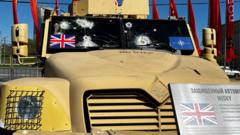39 minutes ago
About sharing
I’m in Victory Park, Moscow’s giant memorial complex dedicated to the Soviet Union’s defeat of Nazi Germany. A new open-air exhibition has just opened.
But it has nothing to do with World War Two.
On display is Western military hardware captured by the Russian army in Ukraine.
They are war trophies and Russia has decided to flaunt them.
Among the armour here is a British Army Husky tactical support vehicle which had been donated to Ukraine. Its windscreen is covered in bullet-holes.
Opposite the Husky I can see Western tanks that had been transferred to the Ukrainian military. There’s an American Abrams which had been damaged on the battlefield. A German Leopard tank, too.
In fact, there’s a long line of German armour. And above it a sign: “History is repeating itself.”
The Russian authorities want the public to think that the war in Ukraine and World War Two have a common denominator: Russia as the victim, under attack from enemies abroad.
In reality, the two wars are very different. In 1941 Germany invaded Russia. In 2022 Russia launched a full-scale invasion of Ukraine.
The war trophy exhibition is packed out.
In bright sunshine Russians are crowding round the military hardware, posing for photographs in front of tank gun barrels and, from the sounds of it, thoroughly enjoying the display.
“It’s incredible. Jaw-dropping,” says Natalya, who’s here with her husband and small daughter.
“It’s amazing to think that our guys managed to get these trophies.”
More than 30 armoured vehicles have been put on display.
But why?
The Russians have not invented the wheel here. In the past Ukraine has displayed Russian military hardware that had been captured by the Ukrainian army.
But for the Russian authorities, this exhibition has, I believe, several key objectives.
The first is to reinforce the Kremlin’s narrative that, in Ukraine, Nato – and the West as a whole – are waging war on Russia. The aim here is to demonise the West yet further in the minds of Russians.
In reality, it was Russia that invaded Ukraine: something Western leaders had urged Moscow not to do. It was President Vladimir Putin’s personal decision to launch what Russia still refers to as the “special military operation” in Ukraine.
With supplies of arms and ammunition, the West came to Kyiv’s defence. It does not seek to destroy Russia, despite what Russian officials may claim.
Then there’s the historical symbolism.
Right now Victory Park is ablaze with red flags commemorating the upcoming Victory Day, the 9 May national holiday which marks Hitler’s defeat.
The venue for this exhibition (a World War Two memorial) and the timing (ahead of Victory Day) feed that other official narrative I mentioned earlier: the one claiming a link between World War Two and the war in Ukraine.
But there’s also a large element of gloating about this exhibition. Regarding the war in Ukraine, the Russians appear increasingly confident, despite the recent $61bn (£49bn) package of US assistance to Kyiv. Moscow believes it now has the initiative on the battlefield.
Russia’s main message is written on a big sign beside the war trophies.
It reads: “Our victory is inevitable.”
1 day ago
5 days ago
6 days ago
